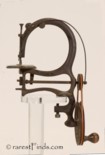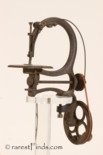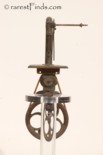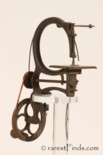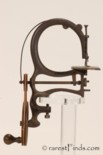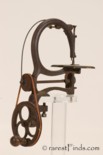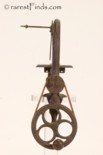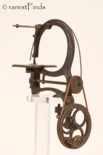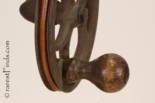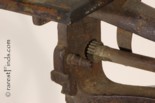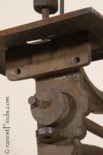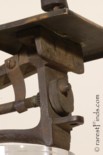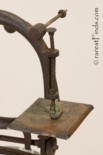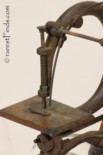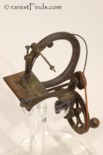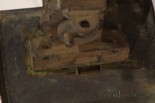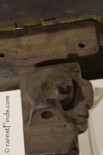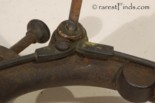The only extant Harrison Sewing Machine; patented on August 9, and August 30, 1859. Price, $5,450.
Click on any thumbnail picture to download large image!
Use browser back-button to go back.
Patents, click on any image to see larger image!
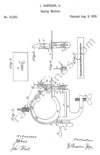
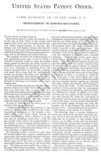
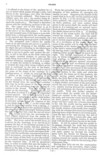
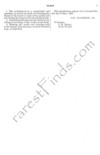
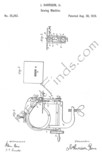

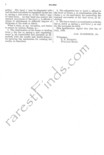
The antique sewing machine patented by James Harrison in 1859 offered here for sale is the only extant machine of its kind other than the patent model in the collection of the Smithsonian Institution in Washington. Yes, I did check the List of the collection of the Museum and the Harrison sewing machine patent model patented on August 9, 1859, is on the list of models in the collection.
The antique Harrison sewing machine utilizes a barbed or bearded needle - also referred to as a needle with a hook at the end instead of a tiny hole for the thread. The needle is operated upside down, in other words, the needle penetrates the fabric from below instead from the top. The earliest machine known using a barbed or bearded needle is the Boynton sewing machine of which two different machines are pictured in Carter Bays's book, THE ENCYCLOPEDIA OF EARLY AMERICAN & ANTIQUE SEWING MACHINES, Third Edition, Fig. 2-43 and Fig. 2-44, on page 55.
The Boynton was a failure and very few machines survived. The Boynton, as the Harrison offered here, feature an integrated clamp to mount the machine on a table and secure the machine. The stitch-plate is made of copper and measures 3-7/8 by 3 inches; the overall height of the machine is 13-3/8 inches, the crank-wheel measures 4-3/4 inches in diameter.
Harrison's antique sewing machine is an improvement over the Boynton machine; Harrison's machine uses also a barbed or bearded needle. The difference is that in Harrison's machine, the needle rotates while it moves up and down. However, the most intriguing, novel, and ingenious idea of Harrison's machine is, a lever feeding the thread to the barb or beard of the needle. This lever is spanning in a semicircular shape all the way from the back of the machine to the needle in front of the machine. This lever is attached to the pulley at the rear end of the power-shaft. The pulley is driven by a leather belt which is driven by the hand-crank. Harrison calls this lever "switch-lever."
Because the so called switch-lever is attached to the pulley at the end of the power-shaft, the lever turns with the pulley and performs a circular motion. This circular motion is transferred to the front of this antique sewing machine where the other end of the switch-lever feeds the thread to the beard or barb of the needle. Harrison claims the following in his Patent as his invention:
The switching-lever n, constructed and operated, as herein set forth, for directing the thread to the beard or barb of the needle and preventing the escape of the thread there from [...].Harrison was aware of the delicate nature of the functioning of his machine, he wrote in his patent application:
It will be perceived that, in order to enable this cam the better to perform its functions, it may be so made and affixed to the disk of the power-shaft as to be susceptible of delicate adjustment.Harrison's patent further notes the weak point of machines which utilize barbed or bearded needles:
It will be noticed that the needle in its passage through the cloth has a tortuous track, twisting the threat from the time the barb first seizes it until it leaves it as a loop and again passes up through the cloth, to again seize the thread for forming another loop.As collectors may be aware, many antique sewing machines - especially small machines meant to be real sewing machines - utilizing barbed or bearded needles are today highly sought after by toy sewing machine collectors. Smal machines with barbed or bearded needles, such as the Remedy, Hancock, Soeze, and others were manufactured past 1900. Most of these machines, if found on occasion, are lacking their needle.
Collectors all want the same; the rarest of the rarest. In other words, collectors are looking for the objects which are very difficult to find or outright unobtainable. Even so this antique sewing machine is incomplete, the very detailed description and the fact that there is a patent model at the Smithsonian Institution, enables a collector to turn this machine into a functioning machine with help of a skilled machinist. I have a friend who manufactured barbed or bearded needles for me which I sold on eBay a while back. If someone wants to make this machine complete, I will provide the name of the individual who is able to manufacture the correct needle for this unique antique American sewing machine.
Condition:
This sewing machine is incomplete and is missing some parts and the barbed needle as you can see in the pictures.
History:
Other than the two patents describing this sewing machine, I was unable to find any other information about it!
Inventory Number 09335;
Price: $ 5450.00.
